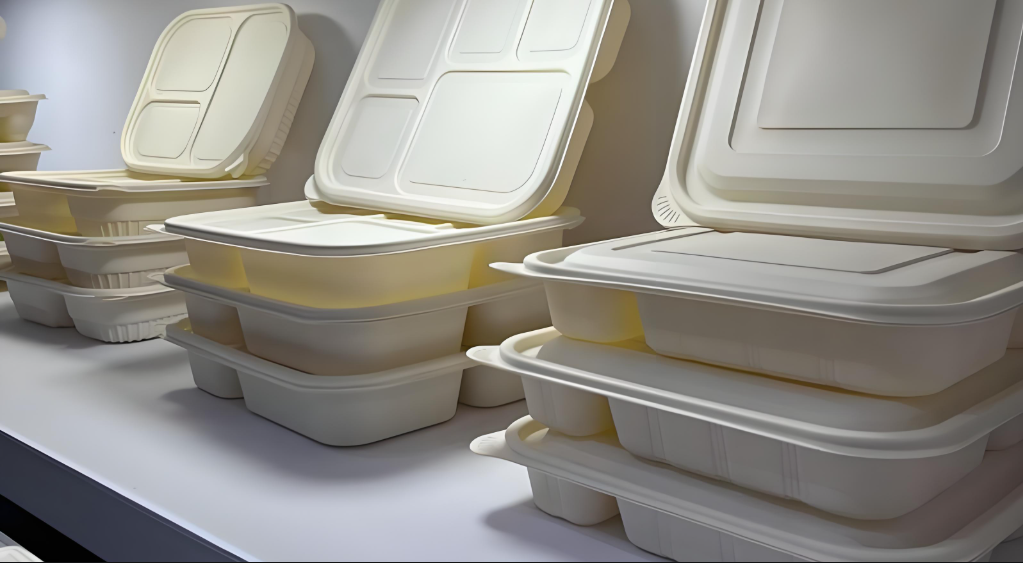The transition toward biodegradable packaging solutions has accelerated dramatically as businesses worldwide seek environmentally responsible alternatives that align with consumer expectations, regulatory requirements, and corporate sustainability commitments. Biodegradable corn starch packaging refers to packaging materials derived from corn starch, categorized as a carbohydrate derived from the endosperm of corn kernels, representing a developing segment of bioplastics with increasing production and usage across food industries, pharmaceutical sectors, textiles, hospitality, e-commerce, toys, and fashion industries.
Understanding Corn Starch Container Technology
Corn starch containers represent sophisticated biodegradable packaging solutions that combine renewable resource utilization with advanced polymer science to create high-performance alternatives to conventional plastic packaging. Cornstarch food containers are made from polylactic acid (PLA), which is derived from cornstarch, providing biodegradable and compostable characteristics that offer restaurants, food delivery services, and eco-conscious consumers excellent alternatives to traditional plastic takeout containers.
The manufacturing process transforms corn starch through fermentation and polymerization techniques that convert plant sugars into polylactic acid polymers, creating materials that maintain structural integrity and performance characteristics while offering complete biodegradability under appropriate composting conditions. This technology enables production of containers that function equivalently to conventional plastic packaging while providing environmental advantages through renewable resource utilization and end-of-life biodegradation capabilities.
Advanced corn starch container formulations incorporate additives and processing modifications that optimize performance characteristics including temperature resistance, moisture barriers, and mechanical strength while maintaining biodegradability and compostability certifications. Modern production techniques enable creation of containers with exceptional clarity, dimensional stability, and food safety compliance that meet stringent requirements for direct food contact applications across diverse market segments.
Quality control systems ensure consistent material properties through precise monitoring of polymerization processes, additive integration, and forming parameters that maintain performance standards while preserving biodegradability characteristics. Comprehensive testing protocols validate mechanical properties, barrier performance, and biodegradation rates under various environmental conditions to ensure reliable performance across intended applications.
Performance Characteristics and Functional Benefits
Cornstarch food packaging demonstrates good crack resistance and durability, suitable for cold and hot food applications, maintaining stable performance even after extended use, making it ideal for everyday applications including takeaways, fast food restaurants, and convenient dining through its environmental characteristics and appealing appearance. Temperature resistance capabilities enable use across ranges from freezer storage at -18°C through microwave heating up to 120°C, accommodating diverse food service requirements without compromising structural integrity.
Barrier properties of corn starch containers provide adequate protection against moisture transmission, oxygen permeation, and contaminant infiltration that maintains food quality and safety throughout typical storage and use cycles. While barrier performance may not match specialized synthetic materials for extended shelf life applications, corn starch containers offer sufficient protection for most food service and retail applications where products are consumed within reasonable timeframes.
Mechanical strength characteristics include good impact resistance, flex durability, and load-bearing capacity that enable safe handling, stacking, and transportation without container failure or deformation. Advanced formulations achieve tensile strengths comparable to conventional plastic materials while maintaining lightweight properties that minimize packaging costs and transportation expenses throughout supply chain distribution.
Optical properties encompass excellent clarity and aesthetic appeal that showcase food products effectively while supporting brand presentation requirements. Natural transparency enables product visibility that enhances consumer appeal while surface characteristics accept printing, labeling, and decorative treatments that support marketing objectives and brand differentiation strategies.
Environmental Impact and Sustainability Advantages
The environmental benefits of corn starch containers extend throughout their complete lifecycle, from renewable resource cultivation through end-of-life biodegradation that returns materials to the environment without persistent pollution or microplastic accumulation. Corn starch packaging represents a plant-based packaging polymer with increasing production and usage, supporting agricultural economies while reducing dependence on fossil fuel resources required for conventional plastic production.
Carbon footprint advantages result from renewable feedstock utilization, lower processing energy requirements, and biodegradation processes that avoid long-term environmental accumulation. Life cycle assessments demonstrate significant greenhouse gas emission reductions compared to conventional plastic packaging, particularly when agricultural practices optimize soil carbon sequestration and sustainable farming techniques minimize fertilizer and pesticide inputs.
Biodegradation characteristics enable complete decomposition within 90-180 days under industrial composting conditions that maintain temperatures of 58°C and controlled humidity levels. Home composting may require longer timeframes depending on environmental conditions, but complete biodegradation occurs without toxic residues or microplastic formation that could compromise soil health or ecosystem integrity.
Waste management benefits include compatibility with organic waste streams, reduction of landfill accumulation, and elimination of incineration requirements that generate greenhouse gas emissions. Composting infrastructure development supports circular economy principles while creating valuable soil amendments that enhance agricultural productivity and soil carbon storage capabilities.
Market Applications and Industry Adoption
Food service applications represent the largest market segment for corn starch containers, driven by restaurant industry adoption, food delivery service expansion, and consumer preferences for environmentally responsible packaging options. Cornstarch containers are suitable for everyday applications such as takeaways, fast food restaurants and convenient dining due to their environmental characteristics and good appearance, addressing operational requirements while supporting sustainability objectives and regulatory compliance initiatives.
Retail food packaging applications include prepared foods, deli items, bakery products, and fresh produce packaging where biodegradable characteristics align with product positioning and consumer expectations. Organic food retailers particularly value corn starch containers for consistency with natural product positioning and environmental stewardship messaging that resonates with target customer demographics.
Institutional food service adoption encompasses healthcare facilities, educational institutions, corporate cafeterias, and event catering where sustainability commitments drive procurement decisions toward environmentally responsible alternatives. Large-scale institutional adoption provides volume opportunities while demonstrating environmental leadership that supports organizational sustainability objectives and stakeholder expectations.
E-commerce packaging applications utilize corn starch containers for food delivery, meal kit services, and specialty food products where biodegradable characteristics address consumer concerns about packaging waste while maintaining product protection requirements. Online retail growth creates expanding opportunities for sustainable packaging alternatives that differentiate brands and support environmental positioning strategies.
Economic Considerations and Cost Analysis
Cost structures for corn starch containers reflect raw material pricing, manufacturing complexity, and market scale factors that influence economic viability compared to conventional plastic alternatives. Direct factory pricing ensures affordability while promoting environmental responsibility, producing cost-effective and environmentally friendly biodegradable cornstarch food packaging, demonstrating industry efforts to achieve competitive pricing through manufacturing optimization and scale development.
Raw material costs fluctuate based on corn commodity pricing, processing technology efficiency, and supply chain logistics that influence final container pricing. While premium pricing compared to conventional plastics may exist, cost gaps continue narrowing through technology advancement, production scale increases, and supply chain optimization that improve economic competitiveness while maintaining environmental advantages.
Total cost of ownership analysis encompasses material costs, processing efficiency, transportation expenses, and waste management savings that provide comprehensive economic assessment beyond initial purchase pricing. Reduced waste disposal costs, potential regulatory compliance benefits, and marketing value from environmental positioning can offset higher material costs while providing overall economic advantages.
Volume pricing strategies enable cost optimization for large purchasers while supplier partnerships provide technical support, logistics optimization, and inventory management services that reduce total operational costs. Long-term supply agreements can stabilize pricing while ensuring consistent availability and quality standards that support business continuity and customer satisfaction objectives.
Regulatory Compliance and Certification Requirements
Regulatory frameworks for corn starch containers encompass food safety standards, biodegradability certifications, and environmental claims validation that ensure product safety while supporting legitimate sustainability messaging. FDA approval for food contact applications requires comprehensive testing including migration studies, toxicological assessment, and manufacturing quality standards that validate safety under intended use conditions.
Biodegradability certifications including ASTM D6400, ASTM D6868, and EN 13432 provide third-party verification of composting performance under specified conditions. These standards define testing protocols, performance criteria, and labeling requirements that ensure authentic biodegradability while preventing misleading environmental claims that could compromise consumer confidence and regulatory compliance.
International certification requirements vary across markets, requiring navigation of different standards, testing protocols, and documentation requirements that support global market access. European BPI certification, Australian AS4736 standards, and other regional requirements may necessitate additional testing and validation to ensure compliance with local regulations and market expectations.
Supply chain documentation includes traceability systems, quality certificates, and environmental verification that support corporate sustainability reporting and customer qualification requirements. Comprehensive documentation enables verification of renewable content, biodegradability performance, and manufacturing practices that validate environmental claims and support marketing communications.
Implementation Strategies and Best Practices
Key Implementation Considerations for Businesses:
-
Application Assessment: Evaluate product compatibility, temperature requirements, and storage conditions
-
Supply Chain Integration: Establish reliable suppliers with consistent quality and delivery performance
-
Customer Education: Communicate proper disposal methods and environmental benefits effectively
-
Cost Management: Optimize purchasing volumes and supplier relationships for competitive pricing
-
Quality Assurance: Implement testing protocols and performance monitoring for consistent results
-
Regulatory Compliance: Ensure certification requirements and food safety standards are met
Successful implementation requires comprehensive evaluation of application requirements, supply chain capabilities, and customer acceptance factors that determine suitability for specific business operations. Switching to cornstarch packaging is beneficial to businesses through environmental positioning, regulatory compliance advantages, and consumer appeal that support marketing objectives while addressing sustainability commitments.
Pilot testing programs enable evaluation of container performance under actual operating conditions while gathering customer feedback and operational experience that informs full-scale implementation decisions. Small-scale testing validates functionality, identifies potential issues, and optimizes procedures before committing to large-volume procurement and operational changes.
Staff training programs ensure proper handling, storage, and customer communication that maximizes container performance while educating consumers about proper disposal methods. Training initiatives should address temperature limitations, storage requirements, and disposal instructions that ensure optimal performance while maximizing environmental benefits through proper end-of-life management.
Supplier relationship management encompasses quality agreements, performance monitoring, and continuous improvement programs that ensure consistent container quality while supporting ongoing cost optimization and innovation development. Strategic partnerships with suppliers provide access to technical expertise, market intelligence, and product development resources that enhance competitive advantages and operational efficiency.
Future Outlook and Market Trends
Market growth projections for corn starch containers reflect increasing environmental awareness, regulatory support for biodegradable alternatives, and technology advancement that improves performance while reducing costs. Industry analysts forecast continued expansion driven by food service growth, e-commerce development, and corporate sustainability commitments that create expanding opportunities for biodegradable packaging solutions.
Technology development continues advancing corn starch container performance through enhanced barrier properties, improved temperature resistance, and specialized formulations that address specific application requirements. Innovation initiatives focus on cost reduction, performance optimization, and new application development that expands market opportunities while maintaining environmental advantages and biodegradability characteristics.
Infrastructure development for composting and waste management supports market growth through improved disposal options, consumer education programs, and regulatory frameworks that facilitate biodegradable packaging adoption. Investment in composting facilities, collection systems, and processing capabilities creates enabling conditions for widespread adoption while ensuring environmental benefits are realized through proper end-of-life management.
Global market expansion creates opportunities for manufacturers while driving standardization of quality, certification, and performance requirements that support international trade and technology transfer. Market development in emerging economies provides growth opportunities while technology advancement continues improving cost competitiveness and performance characteristics that enhance market adoption potential.
Conclusion: Strategic Decision Framework
Corn starch containers offer compelling advantages for businesses seeking environmentally responsible packaging alternatives that align with sustainability objectives while maintaining operational functionality and economic viability. The decision to adopt corn starch containers requires comprehensive evaluation of application requirements, cost considerations, supply chain capabilities, and customer acceptance factors that determine suitability for specific business contexts and market positioning strategies.
Success with corn starch containers depends on proper application selection, supplier partnership development, and implementation planning that addresses performance requirements while maximizing environmental benefits and economic advantages. Businesses that invest in thorough evaluation, stakeholder education, and operational optimization can achieve competitive advantages through environmental differentiation while supporting broader sustainability objectives and regulatory compliance requirements.
The evolution toward biodegradable packaging represents a fundamental industry transformation that prioritizes environmental stewardship alongside traditional performance criteria, creating opportunities for early adopters to establish market leadership while contributing to more sustainable consumption patterns and waste management practices that benefit society and environmental protection objectives.






